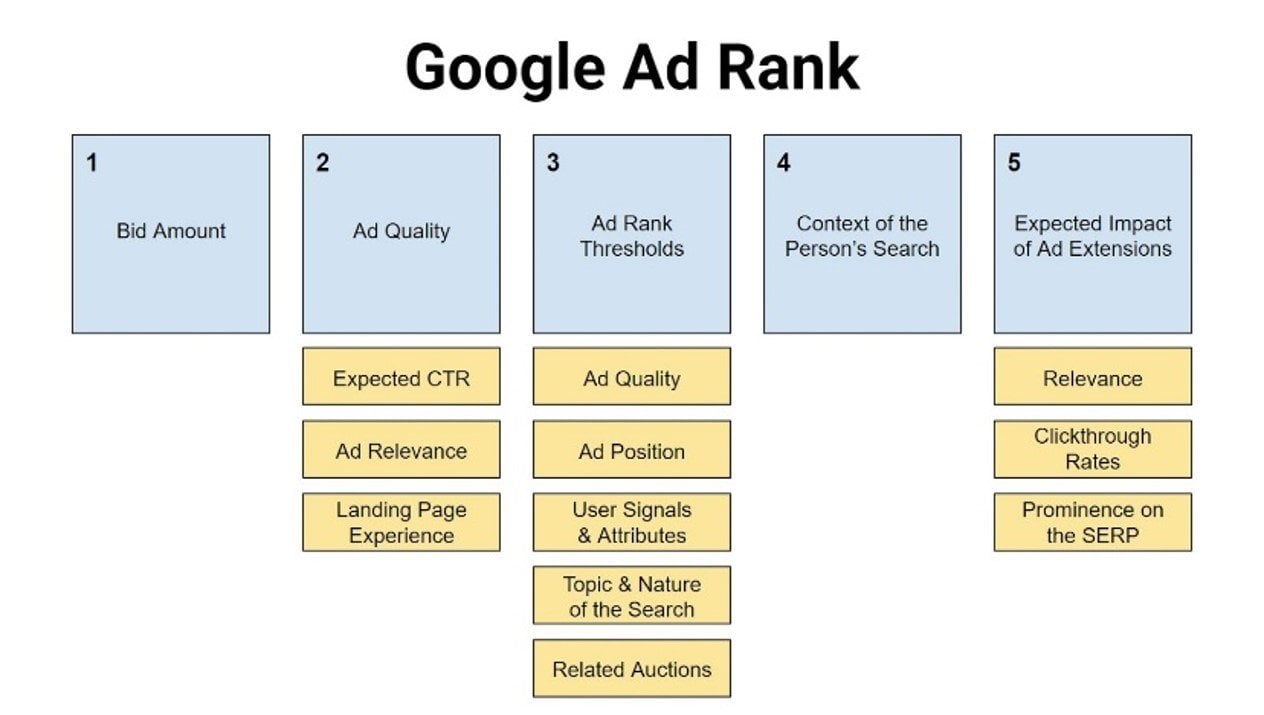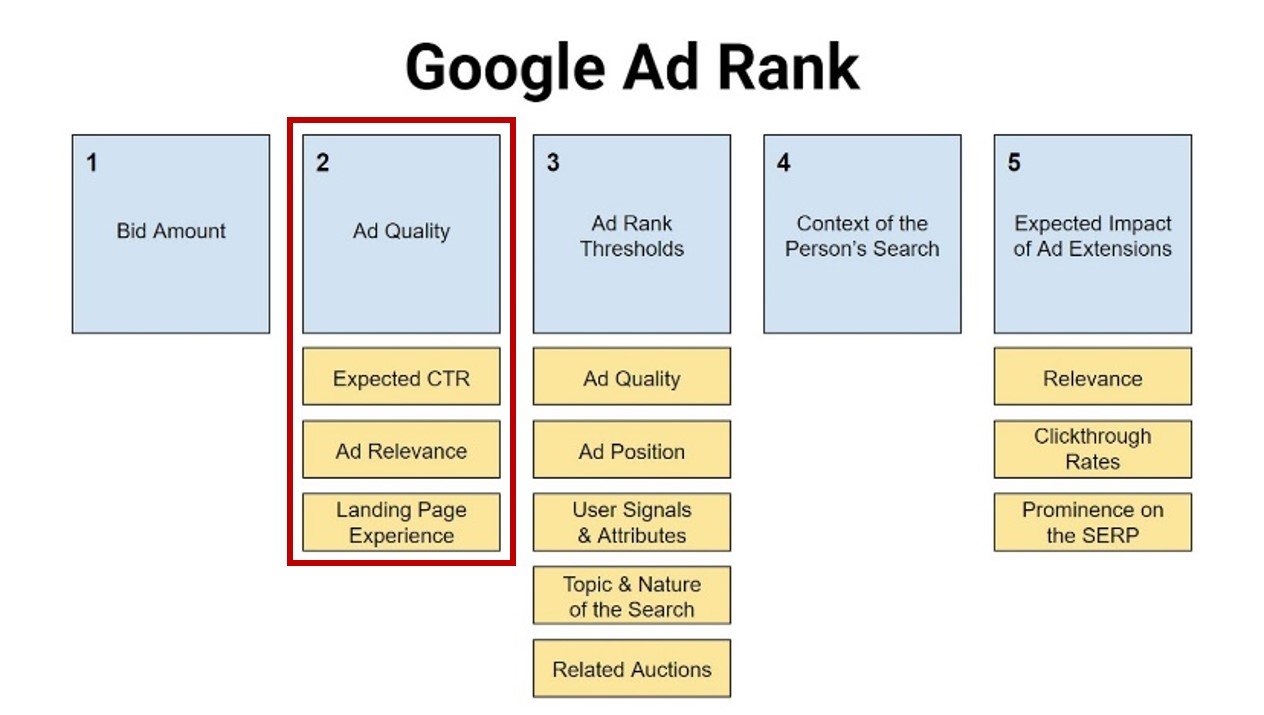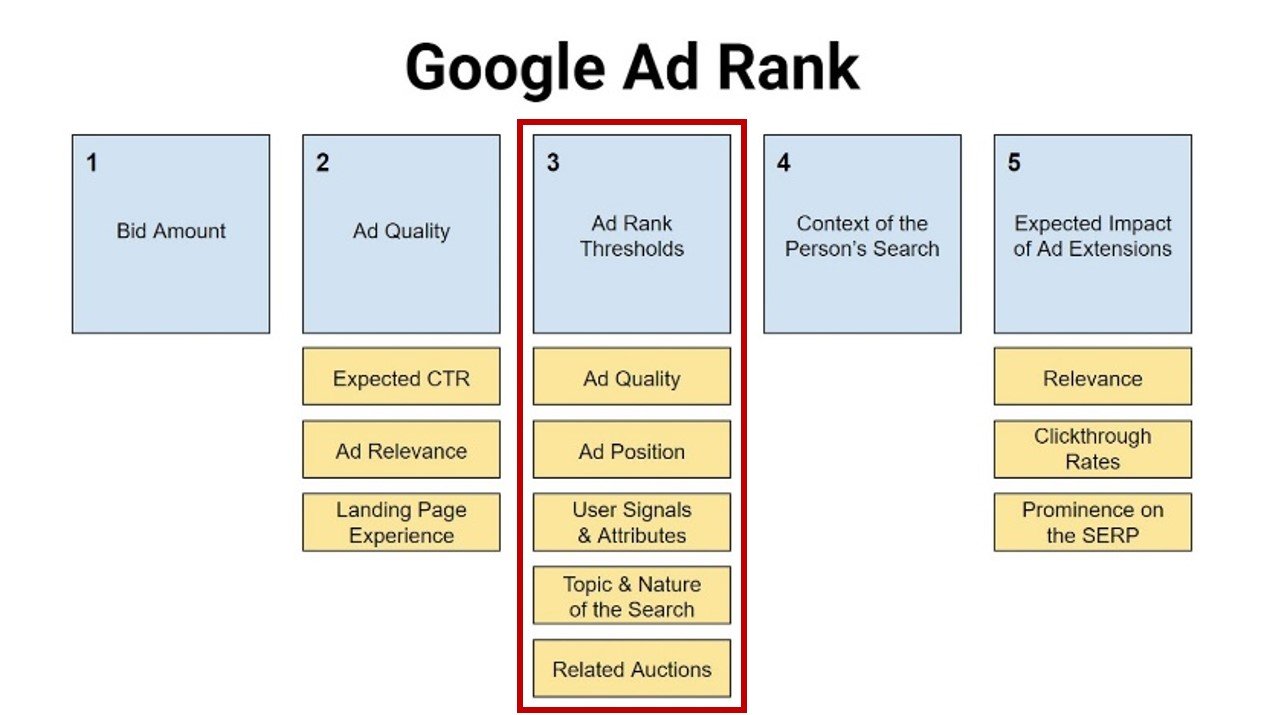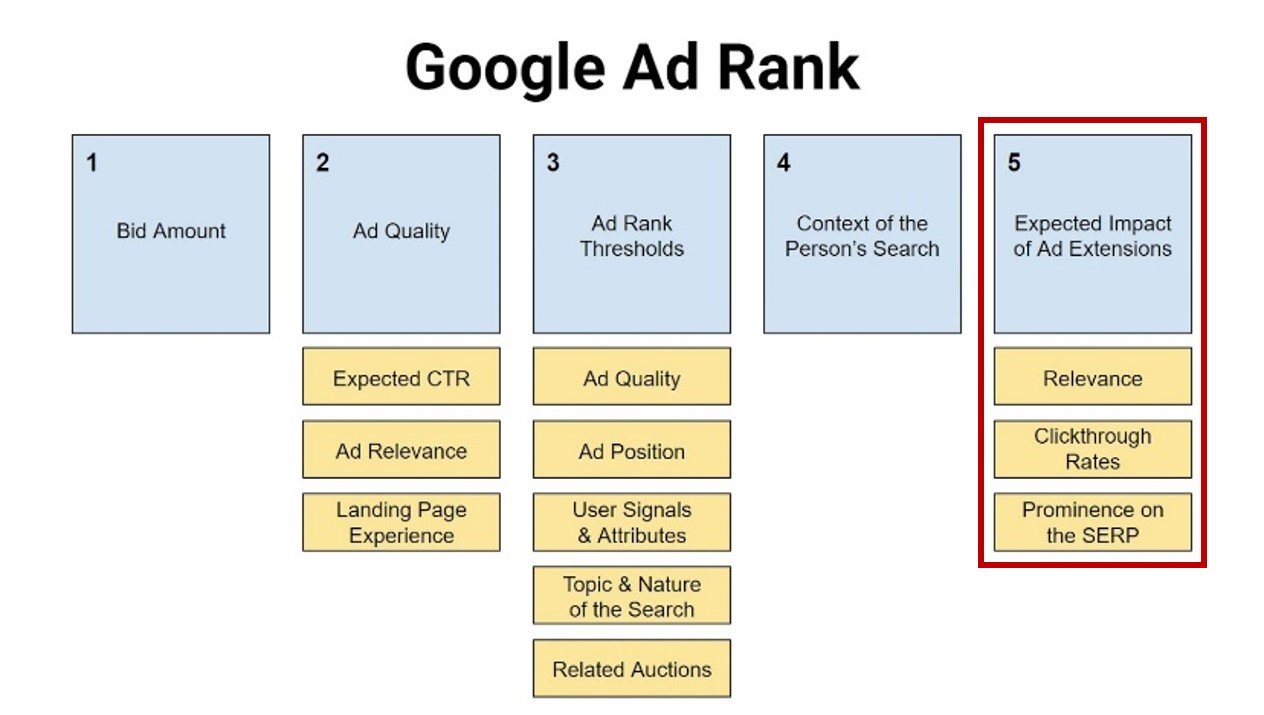Being a pay-per-click advertiser sometimes feels like your hands are tied. You can only do so much to improve the efficiency and the quality of your Google Ads account. Sometimes what you have to work with isn’t all that great. If you want to get the most bang for your buck, Google’s suggestion would probably be simple: add more bucks. But if we look outside of raising bids and budgets, there are other ways to optimize your Google Ads accounts.
One way is to improve your Google Ad Rank, a value that determines where your ad shows up on the search engine results page (SERP). Ad Rank is recalculated every time someone searches for something, so your ad’s Ad Rank will vary from search to search. This variable number could be the difference between your ad showing in the absolute top position of the page and not showing on the first page at all.

As shown above, Ad Rank is made up of five components: bid amount, ad quality, Ad Rank thresholds, the context of the person’s search, and the expected impact of the extensions and other ad formats. Let’s take a closer look at what you can affect in the Ad Rank algorithm to drive significant improvement in your campaign performance.
First, we’ll weed out the components of Google Ad Rank that are outside of our control, as well as the components that require spending more money. Obviously, bid amount is one of those components. Although bid amount is one of the biggest factors in determining Ad Rank, in this scenario we don’t want to spend any more money, so there’s really nothing else to discuss.
The context of the person’s search (the searcher’s location, what device they are searching on, the time of the search, etc.) is another component that is outside of an advertiser’s control, especially when considered within the context of not spending more money. You could, and should, be making bid adjustments to different locations, devices, and various other demographics based on past performance. But outside of that, an advertiser can’t do too much to improve Ad Rank in this department, either.

With those two out of the way, we can get into the meat and potatoes: the importance of ad quality. The quality of an ad – its Quality Score – is made up of three parts, as shown above.
- Expected Clickthrough Rate (CTR) measures the likelihood that a searcher will click on your ad when it’s shown for a specific keyword. It’s measured as “above average,” “average,” or “below average.” If your ads are showing as “below average,” try changing your ad copy so it’s more relevant to your keywords.
- Ad Relevance measures how closely related your keywords are to your ads. It is also measured as “above average,” “average,” or “below average.” Ad relevance is similar to expected CTR in that they both deal with how your ad copy relates to your keywords. However, having a “below average” ad relevance score means that either your keywords are too broad, or that your ad groups have too many broadly-related keywords. It’s better to have a lot of ad groups with a few specific, related keywords versus a few broad ad groups with lots of semirelated keywords.
- Landing Page Experience measures how relevant and useful your website’s landing page will be for a searcher that clicks on your ad for that specific search query. An ad’s landing page experience is also measured as “above average,” “average,” or “below average.” Pages score higher by being organized well, and also by having text on the page that pertains to the search terms. Since our focus here is on what an advertiser can control, we’re going to assume that editing the webpage is not an option. However, if an ad’s landing page experience score is “below average,” there are still a number of ways you can improve it. Try pulling your ad copy directly from the landing page. This should improve your landing page experience, and could also improve your ad relevance and expected CTR if your landing page pertains to your keywords.
By comparing all three ad quality metrics, Google calculates the ad’s Quality Score, which is graded on a scale from one to 10.
One commonality between the three metrics is the recurring theme that ad copy plays a large role in determining ad quality. Advertisers have typically used ad copy to entice searchers to click on their ads. However, if you’ve ever analyzed search-query data, you would know that searchers don’t always read ad copy, or even skim it for that matter. Sometimes people just click on whatever is in the first spot, regardless of whether it’s relevant to what they’re looking for.
That being said, perhaps advertisers could benefit from using ad copy in a different way. Instead of attempting to persuade searchers to click on your ads with stereotypical advertising tropes like, “best prices online” or “satisfaction guaranteed,” advertisers could fill headlines and description lines with a combination of keywords, search terms, and landing page text. This would, in theory, check all the boxes for above-average grades in expected CTR, ad relevance, and landing page experience, giving your ad a Quality Score of 10.

The graphic above shows the difference between an ad with a Quality Score of 10 versus an ad with a Quality Score of nine. A difference of even just one point could mean paying nearly three times as much for a click in the same position.
This is due to the way Google grades your ad versus the other ads in the auction, which is known as Google Ad Rank thresholds. And that’s the next stop in our tour of the five components of Ad Rank. Although Ad Rank thresholds aren’t necessarily something advertisers can control, understanding what goes into determining it is important. Once you understand how it works, you can figure out a way to take advantage of it.
Google’s definition of Ad Rank threshold is as follows: “The reserve price of your ad. If your bid is lower than the threshold, your ad won’t show. And if none of your competitors are eligible to show, the threshold (reserve price) is the price you pay for the click.”
This is where things can get a little confusing, because the Ad Rank Threshold is also determined by five components, and they’re fairly similar to the five components that make up Ad Rank as a whole.

The positions on the SERP are tiered, and each tier has a minimum Ad Rank threshold that your ad must meet in order to compete for that position. As shown above, the tiers are determined by the following five factors:
- Ad Quality: We’ve already talked about ad quality, but how exactly does it factor into the threshold? Google wants the searcher to have a “high-quality ad experience,” so lower-quality ads will have to hit higher thresholds. Essentially, better ads pay less for the same position.
- Ad Position: The higher the position on the page, the higher the threshold will be.
- User Signals and Attributes: Thresholds vary from search to search. The context of a person’s search (location, device, etc.) will affect the thresholds. For example, a search in the United States will have different thresholds than a search in Australia. Similarly, a search on mobile will have different thresholds than a search from a desktop.
- Topic and Nature of the Search: The cost of a click varies from industry to industry. Therefore, thresholds will also vary from industry to industry. If someone is searching for personal injury lawyers, that click is going to be more expensive than a click on an ad for new running shoes.
- Related Auctions: The verbiage of a search can affect the threshold as well. For example, the thresholds of a search for “Nike” running shoes will be similar to the thresholds of a search for “Adidas” running shoes.
Most of what determines Google Ad Rank thresholds is dependent on the searchers and their queries. In fact, outside of spend, ad quality is one of the few things advertisers do have a say in. But there is one more Ad Rank factor you can influence.

With the expected impact of ad extensions, Google takes into consideration how your ad extensions will impact the performance of your ads. It’s another totally free way to improve your ads’ Ad Rank. Using ad extensions typically increases CTR. While it’s not entirely clear if there’s a correlation between expected CTR and actual CTR, it’s not unreasonable to think that if you improve your ad’s CTR it could also improve your expected CTR. An improvement in expected CTR would improve your ad’s overall Quality Score, allowing you to move up into a higher Ad Rank threshold.
So there you have it, the five components of Google Ad Rank. Take your newfound knowledge of how your ad copy influences Ad Rank and optimize your ads to drive stronger PPC campaign performance. The money you will save on clicks will be well worth the time.




